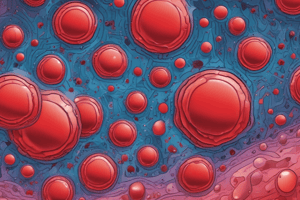Podcast
Questions and Answers
What is the process of formation, development, and maturation of the blood's formed elements called?
What is the process of formation, development, and maturation of the blood's formed elements called?
- Leukopoiesis
- Thrombopoiesis
- Hematopoiesis (correct)
- Erythropoiesis
Which type of cells are responsible for forming all the cells and cell derivatives that circulate in the blood?
Which type of cells are responsible for forming all the cells and cell derivatives that circulate in the blood?
- Platelets
- Pluripotential hematopoietic stem cells (correct)
- Leukocytes
- Red blood cells
What do HSC differentiate into after GM-CSF + IL-3 stimulation?
What do HSC differentiate into after GM-CSF + IL-3 stimulation?
- CFU-E (erythrocyte colony forming unit)
- Platelets
- BFU-E (burst forming unit-erythroid) (correct)
- Leukocytes
What do CFU-E (erythrocyte colony forming unit) express a large number of receptors for?
What do CFU-E (erythrocyte colony forming unit) express a large number of receptors for?
Which characteristic does not belong to stem cells?
Which characteristic does not belong to stem cells?
What represents 7-8% of body weight?
What represents 7-8% of body weight?
'The pluripotential hematopoietic precursor cell (HSC) gives rise to all hematopoietic cells.' What is HSC an abbreviation for?
'The pluripotential hematopoietic precursor cell (HSC) gives rise to all hematopoietic cells.' What is HSC an abbreviation for?
'The stem cells found in the bone marrow in adults are responsible for forming all the cells and cell derivatives that circulate in the blood.' What do stem cells have the capacity for?
'The stem cells found in the bone marrow in adults are responsible for forming all the cells and cell derivatives that circulate in the blood.' What do stem cells have the capacity for?
'It represents 7-8% of body weight.' What does this refer to?
'It represents 7-8% of body weight.' What does this refer to?
'They belong to a tissue. Specific markers. Specific function.' What does this refer to?
'They belong to a tissue. Specific markers. Specific function.' What does this refer to?
What is the protein produced in the kidneys in response to low oxygen levels, which stimulates the production and survival of RBC progenitors?
What is the protein produced in the kidneys in response to low oxygen levels, which stimulates the production and survival of RBC progenitors?
Where is iron absorbed for the production of hemoglobin in RBC?
Where is iron absorbed for the production of hemoglobin in RBC?
What is responsible for the regulation of iron metabolism by binding to ferroportin and preventing iron absorption and release?
What is responsible for the regulation of iron metabolism by binding to ferroportin and preventing iron absorption and release?
Which vitamin is required for DNA synthesis and plays a role in RBC production?
Which vitamin is required for DNA synthesis and plays a role in RBC production?
Where does the destruction of RBC primarily occur?
Where does the destruction of RBC primarily occur?
What is the main consequence of intravascular hemolysis?
What is the main consequence of intravascular hemolysis?
How is anemia defined?
How is anemia defined?
Which type of anemia is commonly caused by iron deficiency?
Which type of anemia is commonly caused by iron deficiency?
What is measured by reticulocyte levels to classify pathophysiological anemias?
What is measured by reticulocyte levels to classify pathophysiological anemias?
Where can extravascular hemolysis occur?
Where can extravascular hemolysis occur?
Flashcards are hidden until you start studying
Study Notes
- Erythropoiesis is the process of producing red blood cells (RBC) from proerythroblasts to reticulocytes.
- Erythropoietin (EPO) is a protein produced in the kidneys in response to low oxygen levels, which stimulates the production and survival of RBC progenitors.
- Iron is essential for the production of hemoglobin in RBC. It is absorbed in the duodenum, transported by transferrin, and stored in ferritin or hemosiderin.
- Erythrocytes have a half-life of 120 days, and are destroyed primarily in the spleen and liver.
- Iron metabolism is regulated by hepcidin, which binds to ferroportin and prevents iron absorption and release.
- Vitamin B12 and folic acid are required for DNA synthesis and play a role in RBC production.
- Hemolysis, the destruction of RBC, can occur extravascularly in the spleen or intravascularly, leading to the release of bilirubin and potential jaundice.
- Intravascular hemolysis can lead to toxicity and damage to the kidney, with potential for hemoglobinuria and hemoglobin appearing in the urine.
- Anemia is defined as a decrease in hemoglobin concentration in the blood, with signs and symptoms dependent on the severity and cause, including asthenia, hypotension, and dizziness.
- Morphological anemias can be classified by mean corpuscular volume, with microcytic anemia most commonly caused by iron deficiency, normocytic anemia found in anemia of chronic diseases, and macrocytic anemia associated with B12 or folic acid deficiency.
- Pathophysiological anemias can be classified based on the bone marrow's ability to produce RBC, measured by reticulocyte levels.
Studying That Suits You
Use AI to generate personalized quizzes and flashcards to suit your learning preferences.




